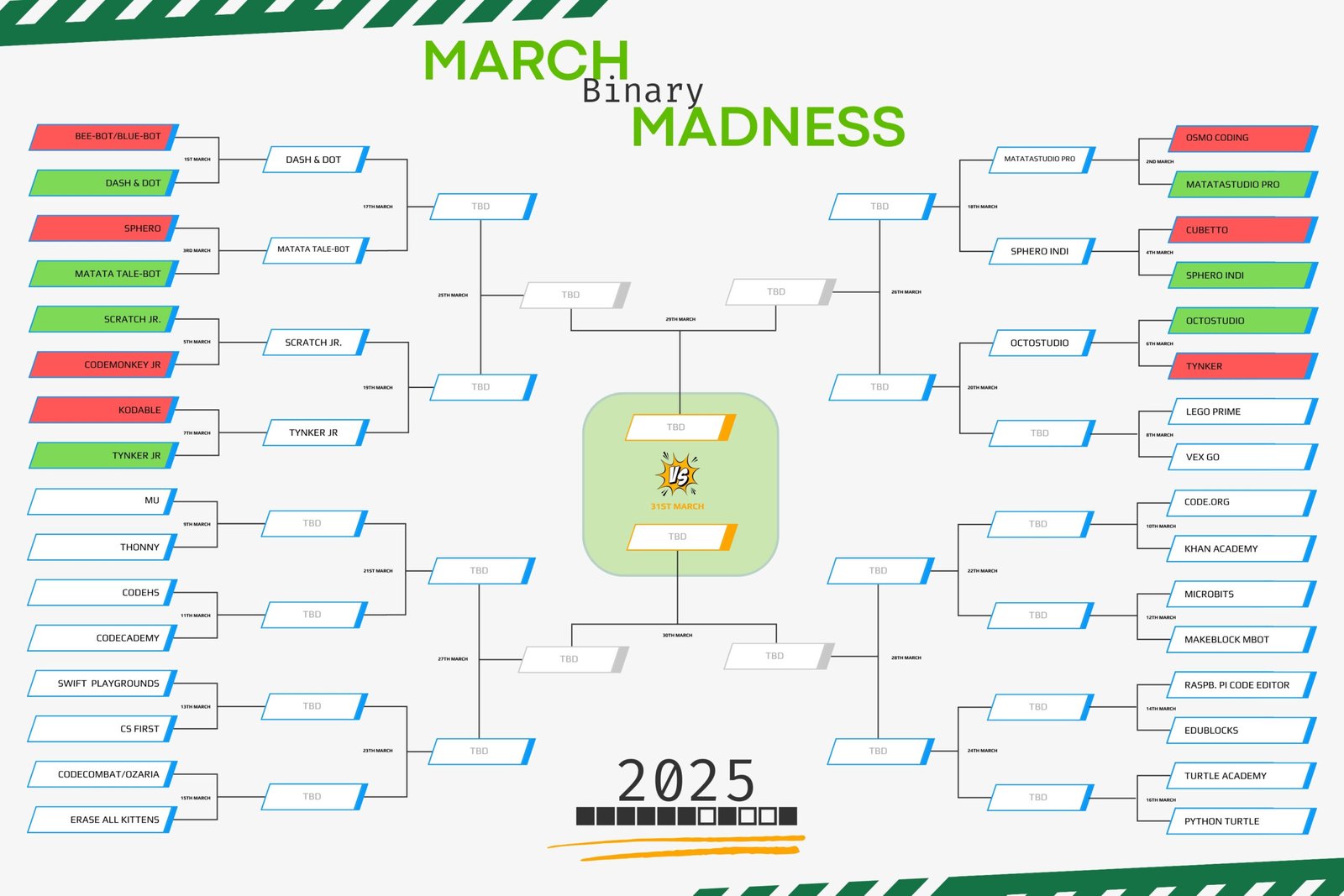The First Week of March Madness: Computing EdTech Showdowns!
March Madness isn’t just for basketball! In the world of educational technology, teachers and edtech enthusiasts have been weighing in on the best tools for classroom coding and robotics. We hosted an exciting series of matchups between some of the most popular learning tools, and the results sparked fantastic discussions. Here’s a deep dive into the first week’s battles and what educators had to say about each contender.
Round 1: Beebot vs. Dash & Dot
One of the first matchups saw Bee-bot take on Dash & Dot, stirring passionate discussions among educators.
- Bee-bot, a staple in many early years classrooms, was praised for its simplicity in introducing algorithms and sequences to young learners. Some educators felt, however, that it lacked versatility beyond basic directional commands.
- Dash & Dot, on the other hand, received overwhelming support for its flexibility and ability to grow with students’ learning levels. With a range of apps and curriculum integrations, many argued it provided a more engaging experience beyond early years.
There was also talk of the VEX 123 robot, which faced criticism for its soft-touch buttons, which were challenging for young children to use effectively. The central button required precise timing—holding it too long would turn the bot off, causing frustration. Additionally, the push-to-start mechanism on track tiles led to excessive pressing, wearing down the non-replaceable wheels. Another issue was the inconsistent width of coding cards, making it difficult for children to return them to their sleeves. Educators noted that physical buttons provide better tactile feedback for young learners, as soft-touch buttons can be less intuitive.
Verdict: The community was split! While Bee-bot initially led, Dash & Dot caught up, showing a divide in preferences based on classroom needs and student age. In the end, Dash and Dot won by just two votes!
Winner: Dash & Dot
Round 2: Unplugged Coding Boards – Osmo Coding vs. Matatalab Studio Pro
The second round moved away from robots to focus on screen-free or off-screen coding tools, with Osmo Coding and Matatalab Studio Pro going head-to-head. Osmo Coding combines physical blocks with a tablet interface, where children arrange coding blocks to control on-screen characters and solve challenges. The combination of digital and physical interaction makes it engaging, though some educators feel it can be a bit limiting in terms of open-ended exploration.
On the other hand, Matatalab Studio Pro offers a more hands-on, tangible experience, using a physical coding board and blocks to program a robot. Unlike Osmo, which requires a tablet, Matatalab focuses entirely on screen-free coding, making it ideal for younger learners who benefit from tactile manipulation. Many educators prefer Matatalab for its open-ended nature, allowing students to experiment with sequencing and problem-solving without being confined to predefined app challenges.
Matatalab was widely praised for fostering creativity, while Osmo was recognised for its guided structure. Educators appreciated both for different teaching styles. This was a comfortable win for Matatalab Studio Pro.
Winner: Matatalab Studio Pro
Round 3: Tale-Bot Pro vs. Sphero
The discussion took a nostalgic turn as Tale-Bot Pro and Sphero faced off.
Tale-Bot Pro was favoured for its rich classroom set, which included washable markers, maps, and interactive challenge booklets, making it highly adaptable for younger students. The robot’s ability to draw paths and follow user-created sequences made it an excellent fit for hands-on, exploratory learning. There was also mention of the multi-language interface which is both inclusive and very child-friendly.
Sphero, already popular in many schools, was acknowledged as better suited for older primary students due to its flexibility and ability to integrate with creative activities, like painting with robotic movement and programming physics-based challenges. Its app-based interface provides more advanced programming options, making it a natural transition for students looking to expand their skills.
Tale-Bot made an early lead, with educators highlighting its classroom-friendly setup, but Sphero remained a strong contender for upper-primary levels. Tale-Bot won this round, but there were a good number of votes for Sphero!
Winner: Tale-Bot
Round 4: Cubetto vs. Sphero Indi
Cubetto, a Montessori-inspired wooden robot, offers a completely screen-free coding experience using physical coding blocks. Designed for early learners, it provides a highly tactile approach to sequencing and debugging. Many educators praised it for its simplicity and alignment with early childhood learning principles.
Sphero Indi, on the other hand, uses colour-coded cards to dictate movement, allowing young learners to engage with coding logic through hands-on interaction. Its intuitive design makes it an accessible tool for beginners while offering some room for progression.
Sphero Indi won with 55% of the vote, but there were good numbers supporting Cubetto and praising its different approach with a Montessori-inspired design.
Winner: Sphero Indi
Round 5: ScratchJr vs. CodeMonkey Jr.
For digital coding platforms, ScratchJr and CodeMonkey Jr. went head-to-head.
ScratchJr, a free and open-ended platform, was praised for its adaptability and ability to introduce coding to young learners without needing pre-planned lessons. With its drag-and-drop block-based coding interface, it encourages creativity and experimentation without requiring literacy skills, making it highly accessible.
CodeMonkey Jr., though more structured, provided a complete curriculum, making it easier for non-specialist teachers to use in lessons. The step-by-step challenges introduce sequencing and logical thinking in a gradual manner, making it an appealing option for classrooms with a more structured approach to teaching coding.
Verdict: ScratchJr had strong support due to its accessibility, and affordability, but some teachers valued the structured approach of CodeMonkey Jr., particularly in formal classroom settings.
ScratchJr took more than 70% of the vote, but it was felt amongst general teachers that some might prefer a more structured approach. was felt among general teachers some might prefer a more structured approach.
Winner: ScratchJr
Round 6: OctoStudio vs. Tynker
Many educators pointed out the challenge of balancing paid and free tools, with some preferring free platforms like OctoStudio for sustainability. OctoStudio, a newer entry into the coding space, has gained traction for its ease of use and project-based approach to creative coding. It allows students to animate characters, create stories, and build interactive projects with a simple, intuitive interface.
Tynker, while a powerful coding platform, requires a subscription for full access. It provides a rich set of lessons, from block-based coding to text-based languages like Python, making it a comprehensive platform for a wide range of learners. However, the cost remains a barrier for some schools and educators.
OctoStudio gained nearly 80% of the vote, with its creativity being cited as a winning combo!
Winner: OctoStudio
Round 7: Kodable vs. Tynker Junior
Kodable and Tynker Junior both cater to early learners, but they approach coding in different ways.
Kodable, while offering a strong early curriculum, was noted for becoming challenging for younger learners as they progress. Its progression from block-based to text-based coding makes it a good long-term investment, but some educators found that younger students struggled with later levels.
Tynker Junior, designed specifically for pre-readers and early elementary students, offers a more gradual introduction to coding with interactive puzzles and game-based learning. It was praised for its engaging visuals and adaptability for different age groups.
Tynker Junior was a clear win for this vote.
Winner: Tynker Junior
Week one results!
So after a full week of voting, here is the current state of our March Binary Madness.

Many of the Educator’s voices and shared experiences were gathered from online Learning communities discussing the Math Binary Madness 2025 match-ups. Join the conversation and vote on the next few entries!
